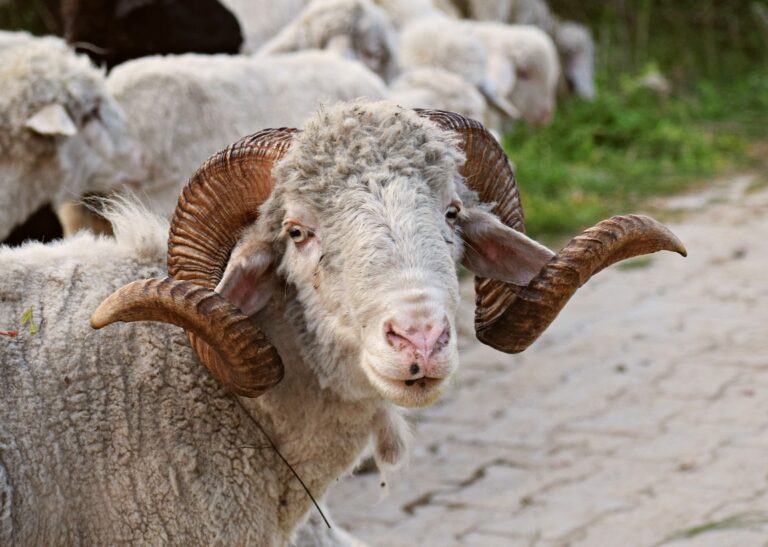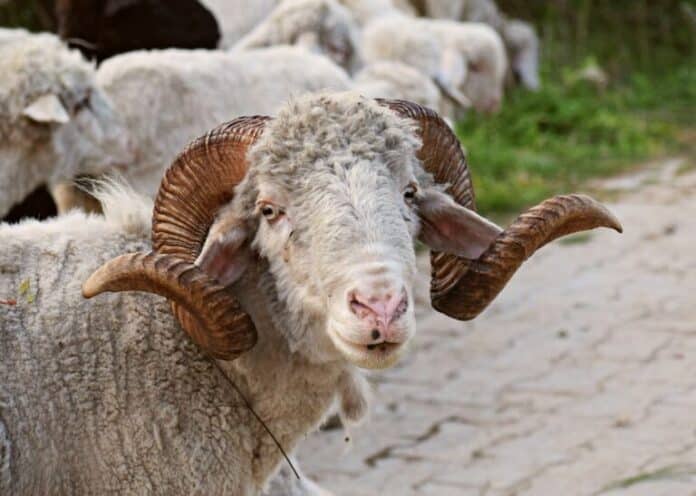Many domestic animals have diverged quite radically from their wild or ancestral counterparts. Let’s look at sheep, for instance.
While it’s true that sheep can grow to be quite large and sometimes physically powerful, they don’t hold a candle to their wild cousins.

In the United States and elsewhere in North America, bighorn sheep are the largest of the mountain-dwelling sheep species.
With huge, curled horns from which they derive their name and surprisingly muscular physiques, these aren’t the cuddly white lambs you think of when you hear the word sheep.
And chances are those horns aren’t for show: are bighorn sheep dangerous?
No, bighorn sheep aren’t considered to be dangerous to humans. Though they’re extremely powerful, very large and heavy and have impressive horns they are so rarely encountered at close range by people that attacks are almost unheard of.
This is one of those situations that, even though an animal has the capability to easily cause immense harm to a human, they aren’t really a problem.
That’s because these animals are almost never encountered at close range in the wild.
Bighorn sheep are so suited to their environment and so elusive it’s almost unthinkable that any human could get close enough in time for a bad encounter to happen before the sheep moved away.
Anyway, there is more to know, so keep reading and I’ll tell you all about them…
Bighorn sheep share many overall characteristics and social structures with their domesticated cousins you’ll find on farms around the world.
Bighorn sheep are heard animals, or flock animals I guess you would say, and in any given group you’ll find mostly females but also males.
Most of the time, there’s little in the way of true conflict until mating season, when sexually mature males will begin to jockey for position, and access, to females.
It is this mating behavior and competition that leads to some of the most well-known encounters that play out between these huge and impressive sheep: when two males square off, they size each other up, circle, back up and then charge before leaping and clashing horns.
In the mountains and hills where these sheep typically live, the resulting crash! can sound like gunshots!
Speaking of where these sheep live, that will give us a clue as to why actual confrontations with humans are so very rare: bighorn sheep tend to live on some of the steepest, rockiest and most impassable terrain in North America.
This gives them ample protection from people and other predators: that’s because bighorn sheep exploit this terrain thanks to their physical adaptations which gives them tremendous grip and sure-footedness when climbing.
Because most people are hard-pressed to even get close to sheep in this terrain, and combined with the excellent senses these animals have, most herds of bighorns will see a person approaching from a long way away. Then, they simply prance away across the mountainside to escape.
Accordingly, circumstances where a bighorn sheep and a human are close enough to actually touch each other, at any time and for any reason, are extremely rare.
No. Although they are generally skittish when they detect any animal that might be a threat, bighorns are not territorial.
There are far more likely to simply move away when they spot trouble, and in any case whole flocks will move from place to place to find food and also engage in migratory behavior and some areas to avoid the worst weather.
Yes, particularly during mating season. Outside of mating season, clashes are generally only social affairs where individual members of the flock that don’t like each other have to work out some aggression and re-establish the pecking order, as it were.
During mating season, sexually mature males will clash with each other to establish dominance and secure access to eligible females.
As a rule, no. This is simply because it’s almost impossible to get close enough to them for the sheep to get aggressive with people.
Chances are extremely high that they will see you coming from a long way away and then just leave, gaining considerable ground since they are so well adapted to the terrain you find yourself in.
But, on the offhand chance that you do, somehow, get close enough to one of these large and powerful sheep, they could prove to be dangerous.
Yes, there have been, though as I mentioned, these attacks are incredibly rare. Among all wild animal species in total, there are so few Bighorn sheep attacks on people in the wild that they can hardly be said to happen at all.
A bighorn sheep is only likely to become aggressive if you get close to it, particularly during mating season or if you come upon a ewe that has lambs.
Once again, the circumstances under which such an encounter might happen are vanishingly rare.
If, for whatever reason, you do see bighorn sheep in the wild and you could get close to them, hold that intrusive thought at bay and just keep away.
Incredibly strong, especially compared to other mammals. These sheep have to be strong and downright athletic to live and thrive in the environments that they inhabit.
Bighorn sheep can commonly be seen leaping across chasms, clambering up and down seemingly vertical and impassable rock faces and maintaining a trot or canter across vast distances that would make most cross-country runners green with envy.
Even looking at their fights, ones that happened between males anyway, we see that their endurance really is legendary. Some clashes will go on for the better part of a day before one male submits!
Bighorn sheep do have teeth and can bite, but it is highly unlikely that they would try to bite you when they could just lead with their huge and incredibly hard horns instead.
A bighorn sheep attack looks exactly how you are imagining it: they charge and ram, utilizing their immense horns combined with their speed and body weight to deliver immense impacts on opponents.
If you were to be attacked by a bighorn sheep and then knocked to the ground, it would either continue head-butting you or perhaps stomp and kick you for good measure.
And again, these are not common domestic sheep: adult bighorns can weigh more than 400 pounds (180 kilos), and some impressive male specimens can clear 500 pounds (226 kilos). The horns alone on a male weigh around 25 pounds and can weigh a lot more.
Now consider that males and females alike can dash on flat ground, flatout, at faster than 20 miles an hour and you can do the math if you want to figure out how bad the impact would be.
Put bluntly: if you get rammed by one of these huge sheep, you’re going to be all broken up because of it.
If you, somehow, put yourself in a position to be attacked by a bighorn sheep you’re going to have two major problems.
The first is that you can easily be knocked over an edge or down a steep slope by a ram and that could prove fatal all by itself.
The second problem is that, considering where bighorns live, you will be unlikely to put distance between yourself and the sheep quickly enough once it has become aggressive.
If you have weapons, by all means defend yourself. If you don’t, try to put anything between yourself and the sheep to block a charge, but it had better be something like a boulder, a tree or something else that can actually prevent the impact.
Your flimsy backpack is not going to do much good as a shield.
If this is not an option, lie down on the ground, cover your head and neck and protect yourself as best as you can. Hopefully, when the sheep sees you’re no longer a threat, it will give up and move on.
No. Bighorn sheep, like all sheep, are strictly herbivorous and do not eat meat. That means they won’t eat you.
No, or at least none that are commonly known. Aside from your typical blood-sucking parasites like fleas, ticks and the like, bighorn sheep don’t carry much in the way of germs or other diseases that can be transmitted to people.
 Like what you read?
Like what you read?
Then you’re gonna love my free PDF, 20 common survival items, 20 uncommon survival uses for each. That’s 400 total uses for these dirt-cheap little items!
Just enter your primary e-mail below to get your link:
We will not spam you.


